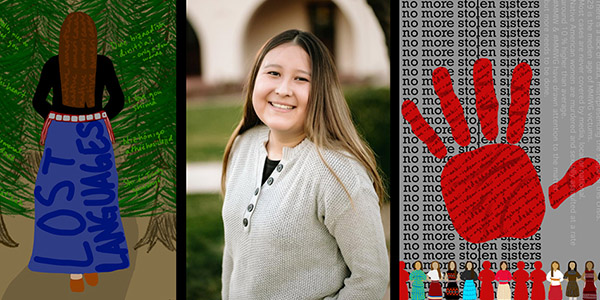Cultural inheritance
In a unique workshop, students explore and honor their personal histories

Trinity Manuelito
“My Navajo culture is what I wanted to tackle,” says MIT second-year student Trinity Manuelito of her work, which uses graphic design to explore four important aspects of that identity. “As I’ve grown older, I’ve done a lot of work to dig into my own identity and learn more about it, because a lot of the information you encounter out there is badly skewed.
“My Navajo culture is really important to me,” says Trinity Manuelito of her IAP course project, which explored key aspects of her identity via design.
Jeff Toney, a visiting professor in the MIT Department of Linguistics and Philosophy who created the IAP course, would like you to think differently about who’s doing the teaching at MIT. He piloted an Independent Activities Period (IAP) project that enabled students to explore the rich trove of knowledge each student already possesses as a cultural inheritance.Toney’s vision for IAP recast his students as the expert curators of a trove of cultural knowledge only they had the keys to unlock. The results are a series of works as diverse as their creators.
“My Navajo culture is what I wanted to tackle,” says MIT second-year student Trinity Manuelito of her work, which uses graphic design to explore four important aspects of that identity. “As I’ve grown older, I’ve done a lot of work to dig into my own identity and learn more about it, because a lot of the information you encounter out there is badly skewed.
A 6-1 (Electrical Science and Engineering) major at MIT, Manuelito challenged herself to communicate accurate information about her culture via an artistic, rather than a technical, medium....I decided to use graphic design, made a list of ideas split between contemporary issues and history, then narrowed the list down to four core ideas and spent a week developing each project.”
Manuelito’s four projects focus on the reservation system, lost languages, the boarding school experience, and the Missing and Murdered Indigenous Women and Girls (MMIWG) movement. Each topic represents an immediate, personal connection for Manuelito, who lived until kindergarten on a reservation and repeatedly returned to visit friends and relatives, including her cheii (maternal grandfather), who attended one of the boarding schools. Manuelito was determined to impart a sense of the personal scope of her topics, which are often taught to non-Natives only within the context of a history class. “I’ve met so many people who are like, ‘You are the first Native American person I’ve ever met!’ There’s this perception that Native Americans lived like, a billion years ago, and they’re all gone, and we’re not! We’re still here,” says Manuelito.
To bring her grandfather’s boarding school experience to life, Manuelito chose the visual metaphor of a bar of soap engraved with the phrase, “Kill the Indian, save the man” — the chilling motto which the boarding schools used to justify their mission of cultural erasure. The soap is more than metaphorical; as Manuelito explained, her cheii was punished for speaking his native language by having his mouth scrubbed out with soap. “Professor Toney put a lot of emphasis on language and the power of words, and within each picture, you can see the words within the picture,” she reports, pointing out the soap bubbles in the work, which are washing away concepts like “family,” “hair,” “words,” and “name.”
Manuelito also brought her talent for a well-chosen word to her work on missing and murdered indigenous women girls, a human rights crisis spanning both the United States and Canada. “If you look closely at the image I created, I put information about the movement and the crisis on the side of the image in a very light, hard-to-read font, which communicates the underlying message that there needs to be more done,” says Manuelito. “That lack of information is honestly reflective of the way Native Americans are treated in society. We need actual numbers for it, we need to get the message about this crisis out in the media.”
Already, Manuelito is seeing her artwork’s effect; her proposal to present at the 48th Annual Symposium on the American Indian has just been accepted, and she is busy preparing her talk. Her work has also hit home in a personal sense: “I took time to talk to my mom and go through all my art. ...The reactions this project has gotten showed me that this work is important and there’s a need for this.”
Suggested links